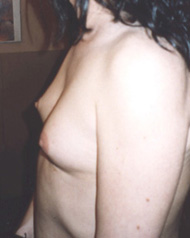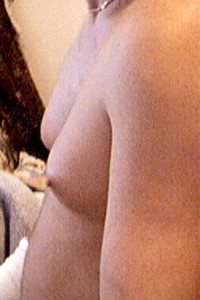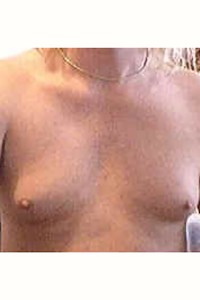|
For all women, breasts are a very
important and very visible aspect of their "womanhood", it is also
probably fair to say that the female breast is regarded as a key
aspect of
feminine beauty,
both in our modern society and historically - and with both men and
women.
The development of breasts gives
the male-to-female transsexual woman a tremendous confidence boost,
and powerfully identifies her as a female to others. It is also
impossible to ignore that the fact that breasts are immensely strong
sexual symbols, and secondary sexual organs whose presence can be
enjoyed by both the owner and their partner. Unlike a vagina,
breasts can be easily and acceptably be publicly displayed in either
part (cleavage) or full (e.g. topless sun bathing), or prominently
implied underneath a skimpy top. Bra's and [usually] breast
forms/padding are essential early purchases for every transsexual
woman.
While ultimately many transsexual woman will
have breast implants, the first step is always female hormone
treatment, using oestrogen and anti-androgens to enable the growth
of breasts to their maximum natural size - although this is somewhat
less than that of close female relatives. Breast growth can often
be enhanced by use of an appropriate progestrogen, causing a more
natural breast shape to form with lactative and ducting tissue as
well as the fatty tissue laid down by oestrogen treatment. If the
woman starts treatment already past puberty, the resulting breast
development can range from respectable to very disappointing -
although even in the later case it should be noted that modern
bra's, "push-ups" and breast enhancers can still do wonders
appearance wise. But the final breast development may still be
regarded as unsatisfactory, particularly in older patients, in which
case implants may be desired.
The Breast
A breast (also known as a mammary gland)
is a quite complex structure consisting of a mass of fatty tissue
and nerves served by a good blood supply. Fully developed, each
breast when lactating is capable of supplying a pint or more a day
of nourishment (milk) and immunoglobulins to a nursing infant.
Visible in the centre of the breast is the protruding nipple, which
is surrounded by a pigmented circular area called the areola. Small
glands in and around the nipple provide lubrication and protection
against infection, which is particularly important for
breast-feeding mothers. Produced by the lobules (consisting of
alveoli) in the interior of the breast, milk is carried to the
nipple by a collection of tubes known as ducts.
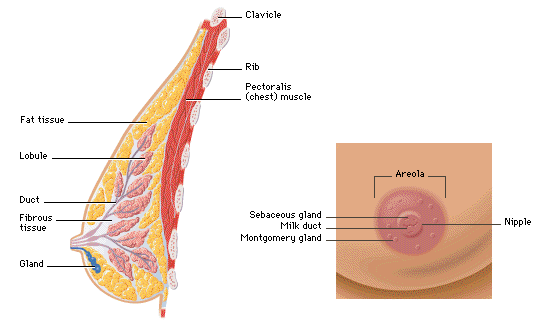
Stages of Mammary (Breast)
Development
At birth the rudiments of the
functional mammary gland are in place: the nipple and areola are
formed along with a rudimentary system of mammary ducts extending
into a small fat pad on the chest wall. The mammary gland remains
a rudimentary system of small ducts until puberty when the advent of
oestrogen secretion by the ovaries brings about the first stage of
the four stages of mammary development: mammogenesis, lactogenesis,
lactation and involution.
Mammogenesis
commences at puberty with the onset of oestrogen secretion by the
ovaries, usually between the ages of 10 and 12 in the genetic girl.
Oestrogen causes enlargement of the mammary fat pad, one of the most
oestrogen-sensitive tissues in the human body, as well as
lengthening and branching of the mammary ducts. About 40% of male
children also initiate mammary development during puberty due to the
tendency of the testis to secrete significant quantities of
estrogens in early phases of its development. As testosterone
secretion increases this function is lost.
Oestrogen stimulates
breast growth by acting on the mammary tissue. With the onset of
the menstrual cycle the presence of progesterone stimulates the
partial development of mammary alveoli, so that by the age of 20 the
mammary gland in the woman who has not been pregnant consists of a
fat pad through which course 10 to 15 long branching ducts,
terminating in grape-like bunches of mammary alveoli. In the
absence of pregnancy the gland maintains this structure until
menopause.
Mammogenesis is completed
during pregnancy, with the gland becoming able to secrete milk
sometime after mid-pregnancy. Pregnancy is often considered to be
the period of most extensive mammary growth. Indeed extensive
lobular and alveolar development occurs only during pregnancy.
Lactogenesis (referred to as
the time when the milk "comes in") starts about 40 hours after birth
of the infant and is largely complete within five days.
When nursing has ceased the gland
undergoes partial involution, losing many of its milk producing
cells and structures, a process that is only completed after
menopause.
Breast Development in the
Transsexual Woman
Every person whether
genetically male or female is born with milk ducts — a network of
canals that transport milk through the breasts — present from
birth. In the male-to-female transsexual woman the mammary glands
stay quiet until commencing female hormone treatment releases a
flood of oestrogen's, causing them to grow and swell in what is
effectively a female puberty and initiating the first phase of
mammogenesis.
| Although often only partially
developed, the breast structure of a transsexual "XY" woman
is basically the same as a genetically "XX" woman after the
first phase of mammogenesis,
indeed transsexuals with well developed breasts are quite
able to nurse given the right stimuli.
It's important to note that all the
common information and rules about the female breast
(including the need for regular breast self-examination and
mammogram's) apply just as much to transsexual women taking
oestrogen as they do to genetic women. |

Transsexual women
must examine their breasts regularly for signs of
problems |
Externally, breast growth and development is
medically defined by "Tanner's Five Stages":
|
Tanner Stage |
Description
(as applies to transsexual woman) |
Example |
|
Stage I
(Pre-hormone treatment) |
The undeveloped
"pre-adolescent" pre-hormone type breast consists of a
small elevated nipple (papilla) only, with no
significant underlying breast tissue. |
 |
|
Stage II
(Hormone treatment
started) |
After 6-8 weeks of hormone
treatment subareolar nodules can be (painfully) felt and
the nipple becomes very sensitive. After about three
months breast buds will visibly start to form.
There is an elevation
of the breast and nipple as a small mound and the areola
diameter may begin to enlarge (particularly in young
women). Milk ducts inside the breast begin to grow. |
 |
|
Stage III |
This stage is reached
after between six months and a year of continuous
treatment.
There is further
enlargement and elevation of the breast and areola (with
no separation of their contours). The areola may begin
to darken in colour. The milk ducts give rise to milk
glands that also begin to grow. |
 |
|
Stage IV |
It will take one to two
years to reach this stage.
There is projection of
the areola and papilla to form a secondary "mound on a
mound" above level of breast. |
 |
|
Stage V |
Only a very few
transsexual women (usually under age 20) reach this
"mature" stage, after perhaps two years hormone
treatment.
The breast has now
fully filled out and only the nipple still projects, the
areola has recessed and become part of the general
breast contour i.e. the secondary mound has disappeared. |
 |
|
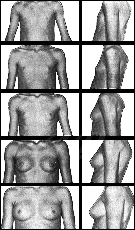
Breast
development, Tanner Stages I to V |
After female hormones are commenced
the breast slowly evolves and gradually increases in
size, often with periods of
growth and periods of apparent standstill. In the initial phase of
oestrogen hormone therapy subareolar nodules, which can be painful,
are common.
Both oestrogen and progesterone
should be taken, it's thought that oestrogen stimulates cell mitosis
and growth of the ductal system, while growth, development and
differentiation of the glandular tissue (called lobules or alveoli)
seems to be dependent on progesterone, and breast fat accretion
seems to require both.

Sarah, a 24 year-old
transgirl after 10, 17 and 26 months on hormones.
|
It may take two years to achieve
full growth so patience is essential. Dissatisfied girls rushing to
seek breast implants after one year may then experienced
complications and misshaped breasts when another spurt of breast
tissue growth sets in. It should also be expected that the breasts
will grow unevenly, e.g. the right may become much fuller that the
left. In the long term the differences will mostly even out, but
even in mature genetic women there is often a quite visible
difference in size and shape between the left and right breasts when
a calm and well-lit study is made of them.

This 53 year-old transwoman has been on hormones (0.675
mg Premarin, 10 mg Progesterone, 2 mg Estrofem) for 7 years. |
The final amount of breast
development obtained by a transsexual woman on hormone treatment is
quite variable, but it known to be very age dependent -
unfortunately the younger the person is and the more recent puberty
(which normally ends between 18 and 20), the better the development
will be. Genetics also plays a very significant role - some people
are genetically predisposed to have copious amounts of fat cells in
therefore large breasts, others practically none. Thus amply
endowed sisters are a promising sign that development will be good,
while flat chest'ed sisters are a serious worry!
Other smaller factors come into
play in determining the size of a woman's breasts, including
nutrition, exercise, health, and weight. For example, if a woman's
body weight falls below its optimum then her breasts can shrink
dramatically as the fat cells in them are burnt up (or in the case
of a skinny transwoman are perhaps never deposited), while if her
weight is above optimum then the apparent or relative size of her
breasts diminishes as they are swallowed by the surrounding
"padding".
The limited evidence would indicate
that maximum results are obtained by starting female hormone
treatment just before the on-set of male puberty, but when
puberty ends (around age 18) a "switch" in the body seems to turn
off and the likely amount of breast development rapidly falls away.
Thus a 12 year-old boy-to-girl will typically end up with well
developed breasts not that much smaller to his sisters and mother,
and the same person starting hormone therapy as a 20 year-old will
often still have quite good results, but as a 30 year-old he/she
will have much less satisfactory results, and will be only slightly
better off than a 40 year-old who in turn will be almost no better
off than a 50 or more year-old.
Anecdotal evidence (clearly there
is a need for medical studies) indicates that the best possible
natural bust development achievable by transwomen, normally young
transwomen, is about one bra cup size less than that average for
close female relatives.
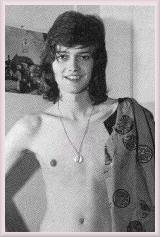

After
augmentation via the inframammary method, Caroline
Cossey became a 36C bra size and displayed a fairly
natural bust appearance in her famous
Playboy spreads. |
It must be emphasised that although
most girls who are able to start hormone treatment while in their
teens will eventually develop full Tanner IV or V, "B" or even "C
cup" breasts, this is still by no means certain. For example the
model Caroline Cossey started hormones at age 17 but owes
most of her famous 36C chest to implants two years later.
Conversely, while most of those women starting hormones when already
in their mature years will achieve only slight Tanner II or III "AA
cup" breast buds, a few will get adequate, even ample, breast
development.
|
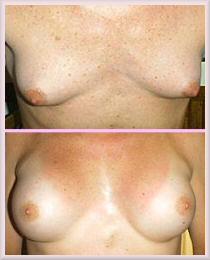
Many transsexual
women suffer from small or under- developed breasts. This
can be helped by eventual breast augmentation.
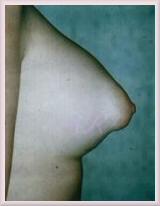
A hypoplastic
tubular breast |
Realistically, most adult
transsexual women starting hormone treatment over the age of 20 will
be very lucky if they eventually genuinely fill a "B cup" bra from
hormone use alone, and those over 30 an "A cup". However, if
letters are important it should be remembered that despite a
perception created by television and the press, the average cup size
of genetic women is actually only "B".
|


Julia and Bia show a breast shape common in transsexual
women who started hormones after puberty but have not
had breast augmentation. |
Also many transsexual women,
particularly those starting hormones over about the age of 25,
suffer from under-developed or hypoplastic breasts. Such breasts
are very small or narrow, lack normal fullness, and may seem bulbous
or swollen at the tip due to an over-prominent nipple-aereolar
complex - their narrow elongated appearance leads them to be termed
"tubular breasts", and nicknamed "snoopy breasts". The shape is
caused by a failure to sufficiently develop the glands and lobules
which help fill out the breast. As a tubular breast consists
primarily of just fatty tissue, milk production and breast feeding
can be problematic - although of course this is very rarely relevant
for transsexual women. The use of a "cocktail" of hormones that
includes both oestrogen and progesterone may help reduce
hypoplasticy.
In older transwomen, their small
breasts are also likely to be spaced widely, and one breast is often
noticeably larger than the other. These problems can make it
difficult to monitor the degree of breast development using the
Tanner scale in mature transsexual women.
Breast Size
Breast size can be quantified by measuring the maximum
hemi-circumference over the nipple with a flexible tape. The
following table shows the results from one study of breast
development, measured in the sitting position, in 500 transsexual
women:
|
Description |
Breast
hemi-circumference |
|
|
Average |
Min. |
Max. |
|
After 12 months
Treatment |
10 cm |
4 cm |
22 cm |
Maximum Development
(After 18-24 months Treatment) |
18 cm |
4 cm |
28 cm |
|
Normal "XX" Female
Development |
22cm |
12 cm |
36 cm |
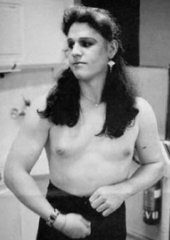 It
clearly shows that the breasts of male-to-female transsexual women
are considerably smaller than genetic XX women. To make matters
worse, the width of the average transsexual woman's thorax is
greater than that of the average female thorax, and so the breast
development is proportional to the chest size even less than the
figures indicate. Consequently, the overall effect and appearance
of their hormone-only induced breasts is judged unsatisfactory by
some 50-60% of MTF transsexual women, and the vast majority of these
seek augmentation mammaplasty (breast implants). It
clearly shows that the breasts of male-to-female transsexual women
are considerably smaller than genetic XX women. To make matters
worse, the width of the average transsexual woman's thorax is
greater than that of the average female thorax, and so the breast
development is proportional to the chest size even less than the
figures indicate. Consequently, the overall effect and appearance
of their hormone-only induced breasts is judged unsatisfactory by
some 50-60% of MTF transsexual women, and the vast majority of these
seek augmentation mammaplasty (breast implants).
Another characteristic
of the breasts of MTF transsexual women compared with genetic women
is the smaller average diameter of their areola, even if the breasts
themselves are actually quite generous in size. Only starting
hormone treatment at a young age seems to avoid this tendency.
Also, because the breasts of transsexual woman rarely reach full
Tanner V size and maturity, their nipples often appear very
prominent - although few women object to this too much!
Examples
The following ladies are
all believed to be transsexual women with natural breasts developed
from hormone use only. I have attempted to classify using the
Tanner stage, this system can be hard to apply to the breasts of
transsexual women and my grading can be debated in several cases.
Notice the relatively small areali, even with the greater
breast development.
Please contact me if
you know that any are not transsexuals, or if they have had breast
augmentation.
<<<
Back to Library Titles
|













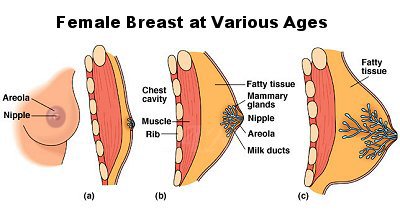















 It
clearly shows that the breasts of male-to-female transsexual women
are considerably smaller than genetic XX women. To make matters
worse, the width of the average transsexual woman's thorax is
greater than that of the average female thorax, and so the breast
development is proportional to the chest size even less than the
figures indicate. Consequently, the overall effect and appearance
of their hormone-only induced breasts is judged unsatisfactory by
some 50-60% of MTF transsexual women, and the vast majority of these
seek augmentation mammaplasty (breast implants).
It
clearly shows that the breasts of male-to-female transsexual women
are considerably smaller than genetic XX women. To make matters
worse, the width of the average transsexual woman's thorax is
greater than that of the average female thorax, and so the breast
development is proportional to the chest size even less than the
figures indicate. Consequently, the overall effect and appearance
of their hormone-only induced breasts is judged unsatisfactory by
some 50-60% of MTF transsexual women, and the vast majority of these
seek augmentation mammaplasty (breast implants).

